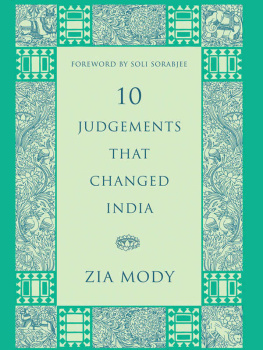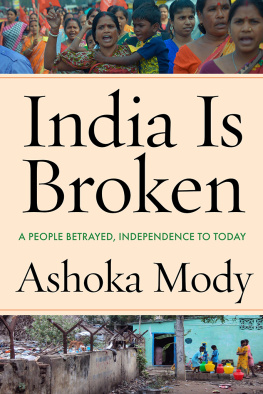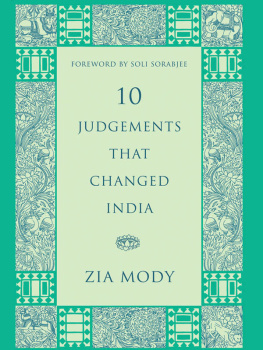Zia Mody - 10 Judgements That Changed India
Here you can read online Zia Mody - 10 Judgements That Changed India full text of the book (entire story) in english for free. Download pdf and epub, get meaning, cover and reviews about this ebook. year: 2013, publisher: Penguin Books Ltd, genre: Religion. Description of the work, (preface) as well as reviews are available. Best literature library LitArk.com created for fans of good reading and offers a wide selection of genres:
Romance novel
Science fiction
Adventure
Detective
Science
History
Home and family
Prose
Art
Politics
Computer
Non-fiction
Religion
Business
Children
Humor
Choose a favorite category and find really read worthwhile books. Enjoy immersion in the world of imagination, feel the emotions of the characters or learn something new for yourself, make an fascinating discovery.
10 Judgements That Changed India: summary, description and annotation
We offer to read an annotation, description, summary or preface (depends on what the author of the book "10 Judgements That Changed India" wrote himself). If you haven't found the necessary information about the book — write in the comments, we will try to find it.
10 Judgements That Changed India — read online for free the complete book (whole text) full work
Below is the text of the book, divided by pages. System saving the place of the last page read, allows you to conveniently read the book "10 Judgements That Changed India" online for free, without having to search again every time where you left off. Put a bookmark, and you can go to the page where you finished reading at any time.
Font size:
Interval:
Bookmark:


THAT CHANGED INDIA

Foreword By Soli J. Sorabjee



Contents
By Soli J. Sorabjee
Kesavananda Bharati v. State of Kerala (1973)
Maneka Gandhi v. Union of India (1978)
Mohammed Ahmed Khan v. Shah Bano Begum (1985)
Olga Tellis v. Bombay Municipal Corporation (1985)
Union Carbide Corporation v. Union of India (1989)
Indra Sawhney v. Union of India (1992)
Nilabati Behera v. State of Orissa (1993)
Supreme Court Advocates-on-Record Association v. Union of India (1993)
Vishaka v. State of Rajasthan (1997)
Aruna Ramachandra Shanbaug v. Union of India (2011)
To my father, Soli Sorabjee,
who is the inspiration behind this book.
To my mother, Zena, for all her encouragement, always.
To Jaydev, my husband, for his unending support and pride.
To my three princesses, Anjali, Aarti and Aditi,
whose unadulterated love keeps me moving on.

Foreword
THE JUDICIARY, AT one time, was considered and projected to be the weakest branch of the state because it possessed neither power of the purse nor power of the sword. That myth has been demolished and the best evidence of it is the set of ten judgements analysed and discussed in this book. Many of the judgements that have been discussed were recognized, even at the time of their pronouncement, as path-breaking and having a profound impact on our nation. To find them being discussed several years later is indeed a testament to their continuing and pervasive relevance.
The Constitution, enacted in 1950, has been the cornerstone of Indias democracy. After its enactment it has undergone several amendments. The Supreme Court is the ultimate interpreter of the Constitution and, by its creative and innovative interpretation, has been the protector of our constitutional rights and fundamental freedoms. The Supreme Court judgement in Kesavananda Bharati v. State of Kerala (AIR 1973 SC 1461) is unique in its impact. It evolved the doctrine of the basic structure of the Constitution and ruled that even a constitutional amendment could be invalidated if it impaired the essential featuresthe basic structureof the Constitution.
The book highlights instances of the manner in which the Supreme Court has performed its role and captures some of the more significant moments in its long and sometimes troubled history.
The judgements described in this book continue to have a real and resounding impact on society as a whole. These decisions are to be appreciated not only as precedents, but also as having laid down the law on issues of paramount importancelaw that is binding on all courts and authorities in the country. In a maturing republic such as ours, the common man must be made aware of and given an understanding of the workings of the law and the judicial process, which very often is seen as the exclusive domain of the legal profession. This book is a step in that direction. Rather than focusing just on the judgements of the court, the author has presented them in context, describing the surrounding cultural and social circumstances and the subsequent reactions of the public and the state to each case, coupled with a commendable legal analysis in language that is not legalese, but reader-friendly.
Zia Mody has made a captivating analysis which, I am sure, will be useful not just for members of the legal profession, but also for parliamentarians, law teachers, students and members of the public who are keen to know about our powerful Supreme Court and the impact of its judgements.
Soli J. Sorabjee
Former Attorney-General of India

Prologue
TO A LARGE and obvious extent, the title of this book shapes the prologue and the contents that follow. I believe that if there is one thing that most Indians still remain deeply proud of and have abiding faith in, it is their judiciary. One of the subliminal expectations of the common man is that justice will be delivered by the highest court of the land: the Supreme Court of India. To the intelligentsia, this is the forum in which both political and executive battles will be calibrated and decided. Many of us, especially practising professionals, take much pride in seeing how the Constitution of India has been infused with life, time after time, by a deft, adept, practical and inspired judiciary.
We take for granted, as a democracy, what many citizens in other countries over the world yearn for: the freedom of speech, access to justice, the right to vote and the right to practise ones religion. In this context, every young student of the law clearly comes to recognize both the independence and the importance of the Indian judiciary in our democratic polity.
Selecting ten judgementsthose that can be termed landmark casesinvolved difficult decisions. The difficulty lay in deciding which judgements not to select simply becauseas is evident when one starts looking at the subjectthe seminal cases and landmark jurisprudence laid down by the highest court of the land have affected the basic liberties of millions of citizens throughout India. Many a time we tried to bring in other seminal judgements as part of the selection. For instance, A.D.M. Jabalpur v. Shivkant Shukla (AIR 1976 SC 1207) has been discussed in the chapter on Maneka Gandhi v. Union of India (AIR 1978 SC 597) (Maneka Gandhi) (Chapter Two); S.P. Gupta v. President of India (AIR 1982 SC 149) has been discussed in the chapter analysing Supreme Court Advocates-on-Record Association v. Union of India (AIR 1994 SC 268) (Chapter Eight); and Minerva Mills v. Union of India (AIR 1980 SC 1789) along with I.R. Coelho v. State of Tamil Nadu (AIR 2007 SC 861) have both been analysed in the chapter discussing Kesavananda Bharati v. State of Kerala (AIR 1973 SC 1461) (Chapter One).
As can be expected, to qualify as landmark decisions, most of these seminal judgements needed to have a distinct constitutional angle. It is interesting to see that from 1947 to 2011, in a short span of sixty-four years, our Constitution has been amended fairly extensively and interpreted fairly expansively. It is probably somewhat removed from what our founding fathers would have anticipated, but, by and large, something they would have been proud of, with the Supreme Court preserving its basic structure.
Each of the ten judgements decided by the Supreme Court demonstrates the central role that the court plays in democratic governance in India. Some of these judgements have arisen as a result of both the pre- and post-Emergency Indira Gandhi regime. During this period, the court was in the throes of a constitutional conflict, torn between deciding on principles and sometimes, unfortunately, bowing to political exigencies. However, the guiding light that one hopes will continue is the ultimate thread of jurisprudence squarely in favour of a strong democracy armed with the unshakeable stamp, the freedom of speech, and the right to life with the other attendant basic constitutional safeguards.
Font size:
Interval:
Bookmark:
Similar books «10 Judgements That Changed India»
Look at similar books to 10 Judgements That Changed India. We have selected literature similar in name and meaning in the hope of providing readers with more options to find new, interesting, not yet read works.
Discussion, reviews of the book 10 Judgements That Changed India and just readers' own opinions. Leave your comments, write what you think about the work, its meaning or the main characters. Specify what exactly you liked and what you didn't like, and why you think so.






